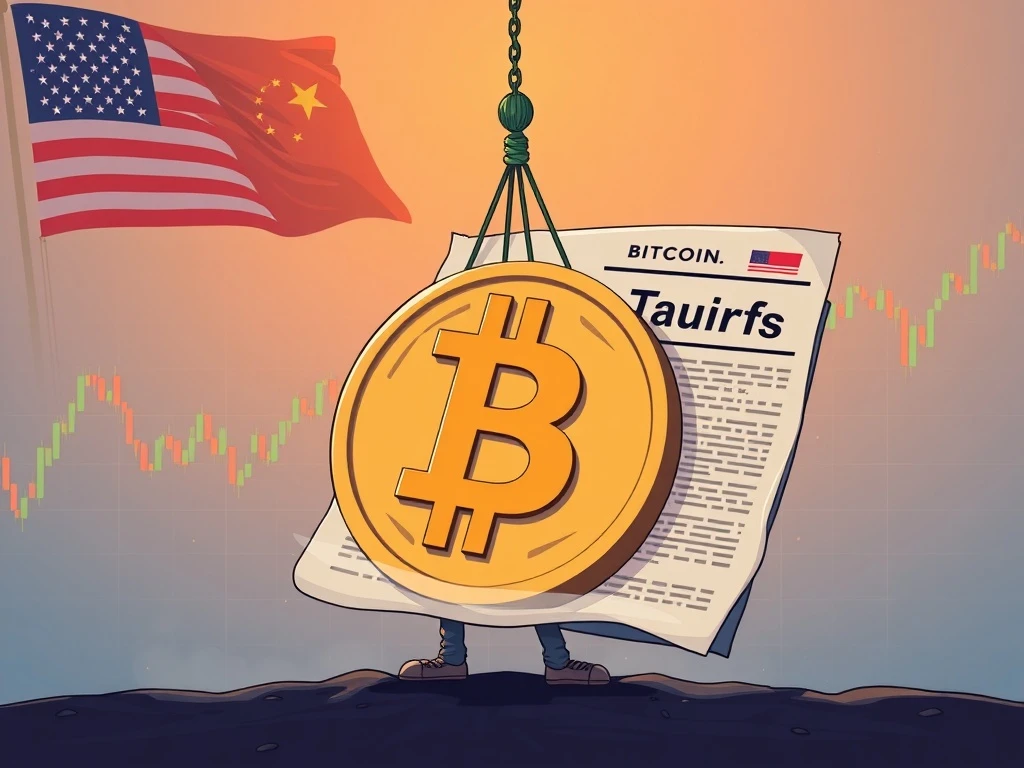Bitcoin Price Under Threat: Trump Tariffs Ignite Crypto Market Uncertainty

The cryptocurrency market often reacts to global events. Currently, Bitcoin wants to climb higher, but external pressures create significant headwinds. Escalating tensions between the US and China, alongside President Trump’s firm stance on tariffs, are major concerns. This geopolitical climate, coupled with Bitcoin traders avoiding long leverage, could push the Bitcoin price to new lows. Investors and analysts are closely watching these developments. Understanding these dynamics is crucial for anyone navigating the volatile crypto landscape.
Bitcoin Price Faces Macroeconomic Headwinds
Deteriorating US-China relations present a significant challenge. President Trump’s recent tariff expansion adds substantial pressure to Bitcoin’s downside. Furthermore, traders are actively avoiding long leverage. This cautious approach compounds the existing market stress. Bitcoin could potentially drop below the significant $100,000 mark. However, analysts maintain hope. They anticipate that next week’s macroeconomic events might reverse the current downtrend. This expectation offers a glimmer of optimism amidst the prevailing uncertainty.
Data indicates Bitcoin’s (BTC) market structure is aiming for balance. This follows last week’s sharp correction. Yet, intensifying headwinds from President Donald Trump’s renewed tariff war with China remain. The record length of the US government shutdown also serves as an overhang. These factors diminish bullish investors’ willingness to open new positions in futures markets. Consequently, the path to sustained upward movement faces considerable obstacles.
Analyzing Crypto Market Analysis and Trader Sentiment
Spot Bitcoin ETF inflows have shown resilience. The Coinbase Premium Index and the spot cumulative volume delta also trend upward. This net difference between market buys and sells for professional and retail-sized investors at Coinbase indicates accumulation. These metrics have steadily increased since Bitcoin sold off to $107,000 on October 10. Such inflows demonstrate persistent demand from a segment of the market. This underlying strength could provide a floor for the Bitcoin price.
As shown in recent charts, the volume delta, funding, and open interest dynamics of the Bitcoin markets have evolved significantly. This evolution occurred since the October 10 sell-off. US retail and institutional investors are clear accumulators of BTC. In contrast, Binance perpetual futures traders have been aggressively selling. This divergence highlights a key market conflict. Spot buyers show demand, while futures traders reinforce a downtrend. This complex interplay shapes current market sentiment.
Comparing Binance spot versus its futures volumes, the spot delta remains positive. Conversely, the negative perps delta highlights rising short-positions. This confirms that perps-driven selling reinforces the downtrend. Spot buyers’ demand, however, provides strength. This demand is particularly evident in the $107,000 to $108,000 range. This dynamic suggests a battle between immediate buying interest and speculative selling pressure. An alternate view of this expression further emphasizes these conflicting forces.
Trump Tariffs and Geopolitical Pressures
The looming threat of Trump tariffs on Chinese goods creates significant global economic uncertainty. Historically, such trade disputes have ripple effects across financial markets. Cryptocurrency, while often seen as uncorrelated, is not immune to these broader macroeconomic shifts. Increased tariffs can lead to higher inflation, reduced consumer spending, and dampened economic growth. These factors collectively reduce investor appetite for risk assets, including Bitcoin. Therefore, the prospect of renewed tariffs casts a long shadow over the crypto market.
The potential for the US administration to ‘TACO again’ refers to the possibility of implementing 100% tariffs on China. Such a move would drastically escalate trade tensions. This scenario could trigger widespread market volatility. Investors might flock to perceived safe havens, or simply reduce exposure to all risky assets. Bitcoin’s performance during such an event would depend on its evolving role in the global financial system. However, initial reactions would likely be negative, pushing the Bitcoin price lower.
Navigating the Short-Term BTC Outlook
Considering Bitcoin’s potential price action in the short-term, the liquidation heatmap outlook offers insights. For instance, on Binance, Bybit, and BitMEX, momentum traders might target liquidation clusters for longs. These clusters are observed at $106,300 to $104,000. Conversely, short positions are at risk of closure at $115,000. These levels represent critical junctures. Traders will closely monitor them for potential price reversals or accelerations. This short-term volatility demands careful risk management.
While prices are expected to stay rocky in the short term, experts see opportunity. Quinn Thompson, Lekker Capital chief investment officer, noted a significant market reset. He stated that the: “10/10 liquidation cleared more leverage in $ and % of OI than the entire Jan-Apr ’25 period. Opportunity ahead is similar to pre-Trump victory ’24.” This perspective suggests that despite immediate challenges, the market might be positioning for a substantial rebound. Such a reset can create attractive entry points for long-term investors. This contributes to a complex BTC outlook.
Key Macroeconomic Triggers for Market Sentiment
Following this vein, macroeconomics-focused account ‘Tom Capital’ advised traders to “just trade the price action.” The upcoming week is expected to provide plenty of actionable events. These events will significantly influence market sentiment. Traders must prepare to navigate multiple narratives:
- US CPI Release: This inflation data can heavily sway Federal Reserve policy expectations.
- Potential US Government Reopening: A resolution to the shutdown could inject confidence into markets.
- Fed Rate Cut (Future Cuts): Expectations around interest rate adjustments impact all asset classes.
- Nikkei Topping at 50,000: This benchmark for Asian markets reflects global economic health.
- Gold Topping: Gold’s performance often signals broader risk aversion or inflation concerns.
- TACO or No TACO: The decision regarding Trump’s self-imposed 100% tariffs on China remains a critical unknown.
These macroeconomic factors collectively create a complex environment. Each event carries the potential to trigger significant market movements. Therefore, diligent monitoring and adaptive trading strategies are essential. Investors must stay informed to make sound decisions. This article does not contain investment advice or recommendations. Every investment and trading move involves risk. Readers should conduct their own research when making a decision.









